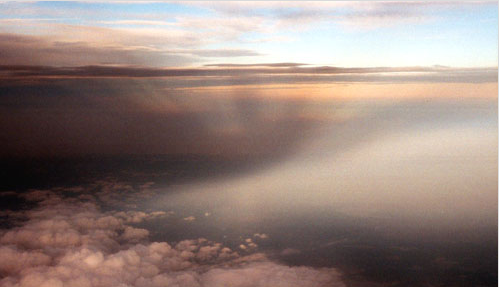Anti-crepuscular rays
Exploring Anti-Crepuscular Rays: Nature's Illusion in the Sky
Have you ever witnessed a breathtaking phenomenon in the sky that left you in awe of nature's wonders? If not, get ready to be captivated by the mesmerizing beauty of anti-crepuscular rays. These ethereal beams of light, often observed during sunrise or sunset, add a touch of magic to the already stunning atmospheric optics display.
Anti-crepuscular rays, also known as antisolar rays, are a rare atmospheric optical phenomenon that occurs when sunlight is scattered by dust, water droplets, or other particles in the atmosphere. Unlike their more commonly known counterpart, crepuscular rays, which appear to converge towards the direction of the setting or rising sun, anti-crepuscular rays seemingly converge towards the opposite side of the sky - the antisolar point.
Here are some fascinating insights about anti-crepuscular rays that will enhance your understanding and appreciation of this captivating natural spectacle:
1. The Illusion of Convergence
One of the most remarkable aspects of anti-crepuscular rays is their apparent convergence towards the antisolar point, which lies directly opposite to the sun. Although these rays may appear to meet at a single point in the sky, they are actually parallel beams of sunlight that only appear to converge due to the perspective from which we observe them.
2. Occurrence During Sunrise and Sunset
Anti-crepuscular rays are typically observed during sunrise or sunset when the sun is low on the horizon. This positioning allows the rays to cast long shadows and create a striking contrast against the backdrop of the sky. However, they can also be seen at other times of the day, depending on atmospheric conditions and the observer's location.
3. The Role of Perspective
The convergence of anti-crepuscular rays is heavily influenced by the observer's position. From an airplane, for example, these rays may appear to converge towards a point below the horizon, while from the ground, they may seem to meet at the zenith. This perspective-dependent illusion adds an extra layer of complexity and wonder to the phenomenon.
4. The Antisolar Point
The antisolar point is the point in the sky directly opposite to the sun. It is the point where anti-crepuscular rays appear to converge. Although it may seem counterintuitive, this convergence occurs because the antisolar point is the direction towards which the parallel rays of sunlight, scattered by atmospheric particles, converge in our line of sight.
5. Enhanced Visibility Against Dark Backgrounds
While anti-crepuscular rays can be observed against any sky background, they are often more easily seen against darker backgrounds such as clouds or mountains. The contrast between the rays and the darker surroundings enhances their visibility, allowing us to fully appreciate their intricate patterns and ethereal beauty.
6. Atmospheric Particles and Scattering
The presence of atmospheric particles, such as dust, water droplets, or even ice crystals, plays a crucial role in the formation of anti-crepuscular rays. These particles scatter sunlight in various directions, creating the mesmerizing effect of converging rays. The scattering process also contributes to the vibrant colors often observed in anti-crepuscular displays.
7. A Celestial Illusion
Anti-crepuscular rays are a celestial illusion that reminds us of the ever-changing and awe-inspiring nature of our atmosphere. The interplay between sunlight, atmospheric particles, and our perspective creates a visual spectacle that sparks our curiosity and deepens our connection with the natural world.
8. Capturing the Magic
Photographing anti-crepuscular rays can be a rewarding challenge for both amateur and professional photographers. To capture these elusive phenomena, it is essential to find a vantage point with an unobstructed view of the sky and choose the right camera settings to bring out the intricate details of the rays. Patience and persistence are key in capturing the magical essence of anti-crepuscular displays.
9. Cultural Significance
Throughout history, anti-crepuscular rays have held cultural significance in various societies. Some cultures perceive them as celestial messages, divine omens, or symbols of spiritual enlightenment. The ethereal nature of these rays has inspired artists, poets, and philosophers, who have sought to capture their beauty and explore their metaphorical meanings.
10. A Reminder of Nature's Splendor
Witnessing anti-crepuscular rays is a humbling experience that reminds us of the vastness and complexity of our universe. It serves as a gentle reminder that even in the midst of our busy lives, taking a moment to marvel at the wonders of nature can fill us with a sense of awe and appreciation for the world we inhabit.
Next time you find yourself gazing at the sky during sunrise or sunset, keep an eye out for the elusive beauty of anti-crepuscular rays. These enchanting converging beams of light are a testament to the marvels of atmospheric optics and serve as a reminder of the extraordinary world we are fortunate to be a part of. Embrace the magic and let your imagination soar as you witness nature's own celestial illusion unfold before your eyes.

Look out for anticrepuscular rays when airborne.
John Allen imaged these from a commercial airliner climbing over northern Florida late afternoon on January 21, 2002. The sun was approximately 12° high - the rays and cloud shadows are converging to the antisolar point the same distance below the horizon. Anticrepuscular rays are sometimes more easily seen against the darker background of the ground. Image ©2002 John Allen, shown with permission.
Note: this article has been automatically converted from the old site and may not appear as intended. You can find the original article here.
Reference Atmospheric Optics
If you use any of the definitions, information, or data presented on Atmospheric Optics, please copy the link or reference below to properly credit us as the reference source. Thank you!
-
<a href="https://atoptics.co.uk/blog/anti-crepuscular-rays-3/">Anti-crepuscular rays</a>
-
"Anti-crepuscular rays". Atmospheric Optics. Accessed on November 30, 2024. https://atoptics.co.uk/blog/anti-crepuscular-rays-3/.
-
"Anti-crepuscular rays". Atmospheric Optics, https://atoptics.co.uk/blog/anti-crepuscular-rays-3/. Accessed 30 November, 2024
-
Anti-crepuscular rays. Atmospheric Optics. Retrieved from https://atoptics.co.uk/blog/anti-crepuscular-rays-3/.